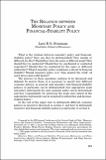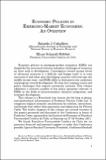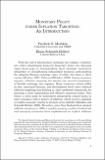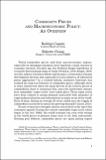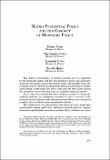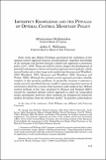Buscar
Mostrando ítems 1-10 de 553
Central banks and sustainability: a comprehensive review of green mandates, speeches, and actions
, there is also an emphasis on how monetary policy should integrate climate change and environmental considerations. This paper aims to examine the various ways central banks are addressing these issues....
The relation between monetary policy and financial-stability policy
What is the relation between monetary policy and financialstability policy? How can they be distinguished? How similar or different are they? Should they have the same or different goals? How should they be conducted? Should they be coordinated or conducted separately? Should they be conducted by the ...
Economic policies in emerging-market economies: an overview
Economic policies in emerging-market economies (EMEs) are shaped by the structural features and policy challenges of countries on their road to development. Convergence toward income levels of advanced countries is a difficult and bumpy road—it is even uncertain if and when most developing countries ...
The fiscal footprint of macroprudential policy
, and this creates seignorage revenues. Inflation unexpectedly rises and this lowers the real value of public debt. Rolling over this debt is cheaper as the price of newly issued debt rises. And finally, economic activity rises, so tax revenues increase and social...
Monetary policy under inflation targeting: an introduction
With the end of intermediate exchange rate regimes, countries are either abandoning domestic monetary policy (by choosing super-hard pegs or relinquishing their national currencies altogether) or strengthening independent monetary policymaking (by adopting floating exchange rates, of either the clean ...
Implications of climate change and ecosystem services degradation for macroeconomic and financial stability: an overview
This volume collects some of the papers presented at the XXVI Annual Conference of the Central Bank of Chile, which took place
in November 2023 in Santiago, Chile.1 The theme of the conference was Implications of Climate Change and Ecosystem Services
Degradation for Macroeconomic and Financial ...
Risks to central-bank independence
their power or remit. These include everything from enhanced financial regulation to quasi-fiscal policy to mitigating economic inequality. Some recent populist proposals appear to be based on the presumption that central banks can issue large quantities...
Commodity prices and macroeconomic policy: and overview
World commodity prices and their macroeconomic impact especially on emerging economies have long been a main concern in economic research. Decades ago the Prebisch-Singer hypothesis of secularly deteriorating terms of trade (Prebisch 1950 Singer 1950) was the subject of intense debate and became a ...
Macro-prudential policy and the conduct of monetary policy
The 'Great Contraction' in global economic activity triggered by the financial crisis and the extraordinary fiscal and monetary measures that public authorities had to undertake in order to put the economy back on track by putting public finances under heavy strains and leading to extremely low ...
Imperfect knowledge and the pitfalls of optimal control monetary policy
Sixty years ago, Milton Friedman questioned the usefulness of the optimal control approach because of policymakers’ imperfect knowledge of the economy and favored instead a simple rule approach to monetary policy (1947, 1948). These are still live issues, despite the development of powerful techniques ...


